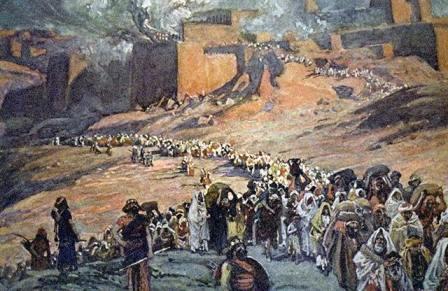Home | About Us | Directions | Bulletins | Sermons & Audio | Cross Of Christ Studies | Classes | Student and Parent Resource Page | Dangers Facing the "Non-Traditional"
Click Here for the Latest Edition of the Auburn Beacon

The Beacon is sent weekly

Sermon Series on the Book of 1 John
by Robert Harkrider

The Final Stages of Israel's Apostasy
Adult
Bible Class in Progress - Sunday
Morning 9:30 - Auditorium Class
Planning to Visit Us?
What
to Expect
Current Class
Information
Thoughts To Ponder
A
pessimist is one who makes difficulties of his opportunities and an
optimist is one who makes
opportunities of his difficulties.
You will need
the following viewers
to view many of the
files on this site.
![]()
Click here to
download
Adobe Acrobat Reader
![]()
Click here to
download
Microsoft PowerPoint Viewer
University church of Christ
Assembly Times
Sunday
Bible Classes (9:30)
AM Worship (10:20)
PM Worship (6:00 pm)
Wednesday
Bible
Classes
(7:00 PM)
Location
449 North Gay Street
Auburn, AL 36830
Click Here for Specific
Directions
Confirmation
by Jefferson David Tant
“Confirmation” is an important factor in life. We want, and need, things to be confirmed, validated or guaranteed. We want things “signed, sealed and delivered,” as a popular song suggests. Statements in court are to be confirmed with an oath “to tell the truth…” Certain documents may be required to be signed in the presence of a Notary Public, etc.
Confirmation is no less important in the spiritual realm. In the NASV translation, the word “covenant” is used 295 times; “promise,” 104 times; “oath,” 66 times, “vow,” 33 times, and “swear,” three times.
God has also been careful to give us assurance of who he is and what he has promised, so that we can have full confidence in our faith. Paul wrote concerning deacons: “For those who have served well as deacons obtain for themselves a high standing and great confidence in the faith that is in Christ Jesus” (I Tim. 3:13).
The point is this: We don’t have to rely on “blind faith,” emotions or guesses. Our faith is based on solid evidence. “Now faith is the assurance of things hoped for, the conviction of things not seen” (Heb. 11:1). “Now faith is the title-deed of things hoped for; the putting to the proof of things not seen” (Montgomery’s NT). “Now faith is the substance of things hoped for, the evidence of things not seen” (NKJV). A building is not fit for occupancy without a firm foundation—that which “stands under.” Thus our faith is a solid foundation, a “sub stance”—that which “stands under” the things for which we hope.
An interesting phrase is seen in one of the prophecies in Daniel 9:27: “And he will make a firm covenant with the many for one week, but in the middle of the week he will put a stop to sacrifice and grain offering; and on the wing of abominations will come one who makes desolate, even until a complete destruction, one that is decreed, is poured out on the one who makes desolate.” While this prophecy deals with the eventual destruction of Jerusalem and the cessation of the Jewish system, it is worthy to consider the idea of God making a “firm covenant.” He has done this many times, but now give attention to how God has confirmed the covenant he made with us concerning our salvation.
Christ obviously is a critical part of the fulfillment of that covenant, and one could not ask for a stronger proof or confirmation of the identity of Jesus Christ beyond what has been furnished. Consider how Christ has confirmed the covenant.
1. By angels. “But the angel said to them, Do not be afraid; for behold, I bring you good news of great joy which will be for all the people; for today in the city of David there has been born for you a Savior, who is Christ the Lord’” (Luke 2:10-11). “The angel said to the women, ‘Do not be afraid; for I know that you are looking for Jesus who has been crucified. He is not here, for He has risen, just as He said. Come, see the place where He was lying’” (Matt. 28:5-6). In addition to angels announcing to shepherds the birth of Christ, and to the women who came to empty tomb, angels also appeared to Mary (Luke 1:26) and Joseph (Matt. 1:20) telling of the birth of Jesus; to Zacharias (Luke 1:11-12) telling of the birth of John, the forerunner of Jesus; and to the soldiers guarding the tomb when Jesus was raised from the dead (Matt. 28:1-4).
2. By John the Baptist. “The next day he saw Jesus coming to him and said, ‘Behold, the Lamb of God who takes away the sin of the world!’” (John 1:29). John had no hesitation in proclaiming the identity of Jesus, who also happened to be John’s cousin.
3. By the Wise Men. “Now after Jesus was born in Bethlehem of Judea in the days of Herod the king, magi from the east arrived in Jerusalem, saying, ‘Where is He who has been born King of the Jews? For we saw His star in the east and have come to worship Him’” (Matt. 2:1-2). What was it that brought these men hundreds of miles to see a baby? How were they led by a particular star? Could it be they were aware of some of the hundreds of prophecies that had been made about the One to come?
4. By the saints then living. “For we did not follow cleverly devised tales when we made known to you the power and coming of our Lord Jesus Christ, but we were eyewitnesses of His majesty. For when He received honor and glory from God the Father, such an utterance as this was made to Him by the Majestic Glory, "This is My beloved Son with whom I am well-pleased" --and we ourselves heard this utterance made from heaven when we were with Him on the holy mountain” (II Peter 1:16-18). There were literally thousands of people who witnessed the miracles and heard the teaching of Christ. They gave living testimony of these events.
5. By Moses and Elijah. “Six days later Jesus took with Him Peter and James and John his brother, and led them up on a high mountain by themselves. And He was transfigured before them; and His face shone like the sun, and His garments became as white as light. And behold, Moses and Elijah appeared to them, talking with Him. Peter said to Jesus, ‘Lord, it is good for us to be here; if You wish, I will make three tabernacles here, one for You, and one for Moses, and one for Elijah.’ While he was still speaking, a bright cloud overshadowed them, and behold, a voice out of the cloud said, ‘This is My beloved Son, with whom I am well-pleased; listen to Him!’” (Matt. 17:1-5). While no statement was recorded by Moses and Elijah,, it was clear from the voice that spoke out of heaven that these great prophets of old were being superseded by one greater than they. They obviously knew who he was. Peter referred to this in the previous point.
6. By certain Pharisees and Jewish rulers. “Now there was a man of the Pharisees, named Nicodemus, a ruler of the Jews; this man came to Jesus by night and said to Him, ‘Rabbi, we know that You have come from God as a teacher; for no one can do these signs that You do unless God is with him’" (John 3:1-2). “Nevertheless many even of the rulers believed in Him, but because of the Pharisees they were not confessing Him, for fear that they would be put out of the synagogue” (John 12:42). Whether they followed him, as Nicodemus may have done, or followed him not, out of fear, they did recognize him for who he was—the Son of God, as he claimed.
7. By the demons that confessed him. “Demons also were coming out of many, shouting, ‘You are the Son of God!’ But rebuking them, He would not allow them to speak, because they knew Him to be the Christ.” (Luke 4:41). When your avowed enemies give testimony on your behalf, you know you are standing on solid ground.
8. By his teaching. “Then, after three days they found Him in the temple, sitting in the midst of the teachers, both listening to them and asking them questions. And all who heard Him were amazed at His understanding and His answers” (Luke 2:46-47). “When Jesus had finished these words, the crowds were amazed at His teaching; for He was teaching them as one having authority, and not as their scribes” (Matt. 7:28-29). “The officers then came to the chief priests and Pharisees, and they said to them, ‘Why did you not bring Him?’ The officers answered, ‘Never has a man spoken the way this man speaks’" (John 7:45-46). The learned scholars were amazed at the knowledge this 12-year-old boy had (Luke 2). The multitudes that heard Christ teach were impressed, and the soldiers who came to arrest him were intimidated at the authority by which he spoke.
9. By his signs and wonders. “And Jesus seeing their faith said to the paralytic, ‘Son, your sins are forgiven.’ But some of the scribes were sitting there and reasoning in their hearts, ‘Why does this man speak that way? He is blaspheming; who can forgive sins but God alone?’ Immediately Jesus, aware in His spirit that they were reasoning that way within themselves, said to them, ‘Why are you reasoning about these things in your hearts? Which is easier, to say to the paralytic, 'Your sins are forgiven'; or to say, 'Get up, and pick up your pallet and walk'? But so that you may know that the Son of Man has authority on earth to forgive sins’ --He said to the paralytic, ‘I say to you, get up, pick up your pallet and go home’ And he got up and immediately picked up the pallet and went out in the sight of everyone, so that they were all amazed and were glorifying God, saying, ‘We have never seen anything like this’” (Mark 2:5-12). “Therefore many other signs Jesus also performed in the presence of the disciples, which are not written in this book; but these have been written so that you may believe that Jesus is the Christ, the Son of God; and that believing you may have life in His name” (John 20:30-31). The enemies of Christ could not deny the reality of the miracles. Indeed, the Jewish rulers had to admit that Christ’s disciples performed miracles. “What shall we do with these men? For the fact that a noteworthy miracle has taken place through them is apparent to all who live in Jerusalem, and we cannot deny it.” (Acts 4:16).
10. By his holy life. “Which one of you convicts Me of sin? If I speak truth, why do you not believe Me?” (John 8:46). “For you have been called for this purpose, since Christ also suffered for you, leaving you an example for you to follow in His steps, who committed no sin, nor was any deceit found in his mouth” (I Pet. 2:21-22). “Now the chief priests and the whole Council kept trying to obtain testimony against Jesus to put Him to death, and they were not finding any. For many were giving false testimony against Him, but their testimony was not consistent” (Mark 14:55-56). When Christ was on trial, only by false testimony could his enemies obtain a conviction. He challenged them to cite one wrong deed he had performed, and they could not do so.
11. By his enemies. “Now the centurion, and those who were with him keeping guard over Jesus, when they saw the earthquake and the things that were happening, became very frightened and said, ‘Truly this was the Son of God!’ (Matt. 27:54). One of the calloused soldiers came to recognize the identity of the one he had nailed to the cross.
12. By a thief who was being crucified with Jesus. “’Jesus, remember me when You come in Your kingdom!’ And He said to him, ‘Truly I say to you, today you shall be with Me in Paradise’" (Luke 23:42-43). Even in his extreme pain, this thief was able to recognize who Christ was by observing his behavior.
13. By his own admission. “So the Jews said to Him, ‘You are not yet fifty years old, and have You seen Abraham?’ Jesus said to them, ‘Truly, truly, I say to you, before Abraham was born, I am.’ Therefore they picked up stones to throw at Him, but Jesus hid Himself and went out of the temple,” (John 8:57-59). Jesus’ use of the words “I Am” is significant, as this expression is indicative of eternal existence. It is the same phrase Jehovah used in Exodus 3:14, as he is instructing Moses to speak to his people. When Moses asks what he should tell them about who sent him, he is told, "Thus you shall say to the sons of Israel, 'I AM has sent me to you.'"
14. By his resurrection and ascension. “Paul, a bond-servant of Christ Jesus, called as an apostle, set apart for the gospel of God, which He promised beforehand through His prophets in the holy Scriptures, concerning His Son, who was born of a descendant of David according to the flesh, who was declared the Son of God with power by the resurrection from the dead, according to the Spirit of holiness, Jesus Christ our Lord” (Rom. 1:1-4). The resurrection of Christ is one of the most provable events of ancient history. No critic has ever been able to refute the overwhelming evidence. Paul cites the fact that over 500 witnesses had seen the resurrected Christ (I Cor. 15:6), and that most of them were alive at the time of his writing, so their testimony could be checked.
15. By prophecy and its fulfillment. “Now He said to them, ‘These are My words which I spoke to you while I was still with you, that all things which are written about Me in the Law of Moses and the Prophets and the Psalms must be fulfilled’” (Luke 24:44). The fact that over 300 prophecies about Christ were each fulfilled to the smallest detail is irrefutable evidence. Some of these prophecies were recorded at least 1,500 years before he was even born. There is absolutely no way this evidence can be discounted or overturned.
16. By changed lives. “Now when they beheld the boldness of Peter and John, and had perceived that they were unlearned and ignorant men, they marvelled; and they took knowledge of them, that they had been with Jesus” (Acts 4:13). Discouraged, defeated and fearful disciples suddenly changed into fearless defenders of what they had seen with their own eyes. Men do not give their lives for what they personally know is a lie.
Dear reader, if you have not already confessed your faith in Christ, and given yourself in obedience to God’s will, I pray that the evidence presented will move you to do this with haste. Surely there are none so blind as those who refuse to see. –Jefferson David Tant
jdtant3@juno.com
11550 Strickland Rd.
Roswell, GA 30076 USA
Other Articles by David Jefferson Tant
The Battle Over the Bible
The Superiority of Christ
Is "Once Saved, Always Saved" a Bible Doctrine?
Should the Lord's Supper be taken
like a meal? May women speak during the Lord's Supper as they would at a
common meal at a table?
Click Here to Read and Hear More About this
Question
![]() Would you like
others to read this article?
Would you like
others to read this article?






